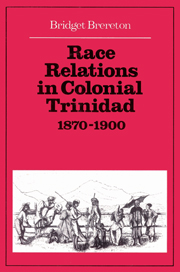Book contents
- Frontmatter
- Contents
- Acknowledgements
- Glossary
- 1 Introduction
- 2 The environment
- 3 The white elite
- 4 Education and mobility
- 5 The rise of a coloured and black middle class
- 6 The urban labouring population
- 7 The black rural masses
- 8 The souls of black folk
- 9 The Indians
- 10 Racism and race relations: the divided society
- Abbreviations
- Notes
- Bibliography
- Index
6 - The urban labouring population
Published online by Cambridge University Press: 08 October 2009
- Frontmatter
- Contents
- Acknowledgements
- Glossary
- 1 Introduction
- 2 The environment
- 3 The white elite
- 4 Education and mobility
- 5 The rise of a coloured and black middle class
- 6 The urban labouring population
- 7 The black rural masses
- 8 The souls of black folk
- 9 The Indians
- 10 Racism and race relations: the divided society
- Abbreviations
- Notes
- Bibliography
- Index
Summary
The black and coloured labouring population in the nineteenth century was very far from being a homogeneous group. In 1870 it included Trinidad ex-slaves and their descendants, mostly Roman Catholic and patois-speaking; immigrants from the eastern Caribbean who came in large numbers all through the century, mainly English-speaking and Protestant; liberated Africans of many different tribes and regions of West Africa who had been freed from foreign slave ships by the British Navy and sent to Trinidad from Sierra Leone and St Helena; black ex-soldiers of the West India Regiment disbanded in 1815 and settled in various parts of the island; ex-slaves from America who had fought for Britain in the War of 1812 and had also been settled in Trinidad; the descendants of free coloured and free black peasants and labourers; and peons of Spanish–African–Amerindian descent who came from Venezuela all through the century. It would be difficult to establish that all these groups shared a common Creole culture, for there were wide cultural, linguistic, and religious differences between them. All one can safely state is that they were rigorously excluded from political or civic life, their most characteristic cultural forms tended to be despised by the upper and middle classes, and they were in a low economic position: they were plantation labourers, smallholders, squatters, hunters, lumbermen, fishermen, artisans, longshoremen, domestic servants, vagrants, unemployed, and criminals.
In the last thirty years of the century, the black and coloured masses were being increased year by year by an influx of immigrants from the eastern Caribbean and especially from Barbados.
- Type
- Chapter
- Information
- Race Relations in Colonial Trinidad 1870–1900 , pp. 110 - 129Publisher: Cambridge University PressPrint publication year: 1980



